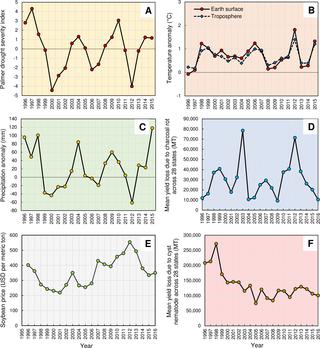PLOS ONE ( IF 2.9 ) Pub Date : 2020-04-02 , DOI: 10.1371/journal.pone.0231141 Ananda Y Bandara 1 , Dilooshi K Weerasooriya 1 , Carl A Bradley 2 , Tom W Allen 3 , Paul D Esker 1

|
Soybean (Glycine max L. Merrill) is an economically important commodity for United States agriculture. Nonetheless, the profitability of soybean production has been negatively impacted by soybean diseases. The economic impacts of 23 common soybean diseases were estimated in 28 soybean-producing states in the U.S., from 1996 to 2016 (the entire data set consisted of 13,524 data points). Estimated losses were investigated using a variety of statistical approaches. The main effects of state, year, pre- and post-discovery of soybean rust, region, and zones based on yield, harvest area, and production, were significant on “total economic loss” as a function of diseases. Across states and years, the soybean cyst nematode, charcoal rot, and seedling diseases were the most economically damaging diseases while soybean rust, bacterial blight, and southern blight were the least economically damaging. A significantly greater mean loss (51%) was observed in states/years after the discovery of soybean rust (2004 to 2016) compared to the pre-discovery (1996 to 2003). From 1996 to 2016, the total estimated economic loss due to soybean diseases in the U.S. was $95.48 billion, with $80.89 billion and $14.59 billion accounting for the northern and southern U.S. losses, respectively. Over the entire time period, the average annual economic loss due to soybean diseases in the U.S. reached nearly $4.55 billion, with approximately 85% of the losses occurring in the northern U.S. Low yield/harvest/production zones had significantly lower mean economic losses due to diseases in comparison to high yield/harvest/production zones. This observation was further bolstered by the observed positive linear correlation of mean soybean yield loss (in each state, due to all diseases considered in this study, across 21 years) with the mean state wide soybean production (MT), mean soybean yield (kg ha-1), and mean soybean harvest area (ha). Results of this investigation provide useful insights into how research, policy, and educational efforts should be prioritized in soybean disease management
中文翻译:

剖析二十年来美国大豆病害的经济影响。
大豆( Glycine max L. Merrill)是美国农业的重要经济商品。尽管如此,大豆生产的盈利能力仍受到大豆病害的负面影响。评估了 1996 年至 2016 年间美国 28 个大豆生产州 23 种常见大豆病害的经济影响(整个数据集包含 13,524 个数据点)。使用各种统计方法对估计损失进行了调查。基于产量、收获面积和产量的州、年份、大豆锈病发现前后、地区和地区对作为疾病函数的“总经济损失”具有显着影响。在各州和年份中,大豆胞囊线虫、木炭腐病和幼苗病害是经济破坏性最大的病害,而大豆锈病、白叶枯病和南方疫病则是经济破坏性最小的病害。与发现前(1996 年至 2003 年)相比,发现大豆锈病后(2004 年至 2016 年),各州/年份的平均损失显着增加(51%)。 1996年至2016年,美国因大豆病害造成的经济损失估计为954.8亿美元,其中美国北部和南部的损失分别为808.9亿美元和145.9亿美元。整个时期内,美国因大豆病害造成的年均经济损失接近 45.5 亿美元,其中约 85% 的损失发生在美国北部低产/收获/生产区,由于大豆病害造成的平均经济损失明显较低与高产/收获/生产区相比的疾病。 观察到的平均大豆产量损失(在每个州,由于本研究中考虑的所有疾病,21年来)与全州平均大豆产量(MT)呈正线性相关,进一步支持了这一观察结果,平均大豆产量(公斤) ha -1 ) 和平均大豆收获面积 (ha)。这项调查的结果为如何在大豆病害管理中优先考虑研究、政策和教育工作提供了有用的见解











































 京公网安备 11010802027423号
京公网安备 11010802027423号